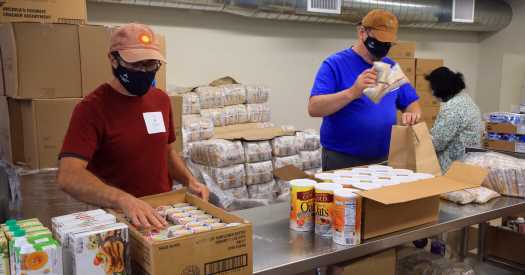Vast Expansion in Aid Kept Food Insecurity From Growing Last Year

Despite the economic downturn, government figures for 2020 show no overall rise in hunger of the sort typical in past recessions. But some groups still suffered.
By Jason DeParle
Despite the sudden loss of 20 million jobs at the start of the coronavirus pandemic, food insecurity among Americans remained unchanged last year, the government reported Wednesday, in what researchers called a testament to a vast expansion of government aid.
As lines outside food banks stretched for miles in March 2020, experts feared the country faced a looming hunger crisis. But bipartisan legislation signed by President Donald J. Trump offered billions in emergency aid, forestalling the expected rise in hunger that has accompanied past recessions and keeping levels of hardship flat.
“This is huge news — it shows you much of a buffer we had from an expanded safety net,” said Elaine Waxman, who researches hunger at the Urban Institute in Washington. “There was no scenario in March of 2020 where I thought food insecurity would stay flat for the year. The fact that it did is extraordinary.”
The government found that 10.5 percent of American households were food insecure, meaning that at some point in the year they had difficulty providing enough food to all members of the home, because of a lack of money. It also found that 3.9 percent had “very low food insecurity,” meaning the lack of resources caused them to reduce their food intake. That was statistically unchanged from the previous year.
Food insecurity did rise among some groups, including households with children, Black Americans, and households in the South. The gap between Black and white households, which was already large, widened further, with 21.7 percent of Black households experiencing food insecurity, compared with 7.1 percent of white households. That is a gap of 14.6 percentage points, up from 11.2 points in 2019, before the pandemic struck.
Black households suffered disproportionately from pandemic-era job loss and had fewer assets with which to buffer a crisis.
Still the overall pattern of constraining the effects on hunger contrasted sharply with the country’s experience during 2008, when nearly 13 million additional Americans became food insecure at the start of Great Recession. Last year, 38.3 million Americans were food insecure, a level far below the 50.2 million food insecure Americans at the Great Recession’s peak.
With President Biden pushing a $3.5 trillion legislative program that would further expand the safety net, the report from the Agriculture Department on Wednesday provided fodder for both sides. Supporters say it shows the value of expanded government spending, while critics say the unchanged rates of food hardship shows further spending is not necessary.
The program expansions reflected in the report, such as the first round of stimulus checks and unemployment expansions, occurred early in the pandemic. But several large subsequent rounds of aid have followed, most recently in a $1.9 trillion spending package in March that, among other things, offered monthly cash payments to nearly all families with children.
“A lot of us warned that those further expansions were unnecessary and this provides additional support that that was true,” said Angela Rachidi, a hunger expert at the American Enterprise Institute. She warned that progressives were pushing a narrative of exaggerated hardship to justify continued spending increases.
Site Index
Site Information Navigation
Source: Read Full Article


